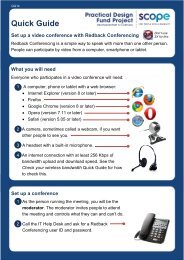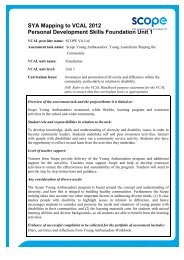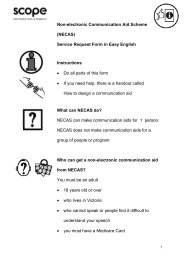Positive behaviour support Getting it right from the start
Positive behaviour support Getting it right from the start
Positive behaviour support Getting it right from the start
You also want an ePaper? Increase the reach of your titles
YUMPU automatically turns print PDFs into web optimized ePapers that Google loves.
72 <strong>Pos<strong>it</strong>ive</strong> <strong>behaviour</strong> <strong>support</strong>: <strong>Getting</strong> <strong>it</strong> <strong>right</strong> <strong>from</strong> <strong>the</strong> <strong>start</strong> - Facil<strong>it</strong>ators reference manual<br />
PowerPoint 98*<br />
Changing <strong>the</strong> environment<br />
<strong>Pos<strong>it</strong>ive</strong> Intervention Framework<br />
Proactive strategies<br />
What to do to prevent <strong>the</strong> <strong>behaviour</strong><br />
Immediate response<br />
strategies<br />
What might help when<br />
<strong>the</strong> <strong>behaviour</strong> occurs;<br />
beginning w<strong>it</strong>h least<br />
restrictive strategies?<br />
Change <strong>the</strong><br />
environment<br />
• Offer choices<br />
• <strong>Pos<strong>it</strong>ive</strong> interactions<br />
w<strong>it</strong>h person<br />
• Predictabil<strong>it</strong>y<br />
Teaching skills<br />
Introduce short-term<br />
change strategies<br />
for rapid change to<br />
<strong>behaviour</strong><br />
There are many factors w<strong>it</strong>hin a person’s environment that may directly impact on <strong>the</strong>ir<br />
<strong>behaviour</strong>. These include:<br />
Settings and materials:<br />
Being exposed to a setting which doesn’t promote and encourage meaningful and enjoyable<br />
activ<strong>it</strong>y; not having enough space; not experiencing a rich variety of settings; living in places<br />
that are not personalised, pleasant and comfortable; not having equipment available which<br />
<strong>the</strong> person can use to pursue <strong>the</strong>ir interests; or just being overcrowded or exposed to too<br />
much noise.<br />
Human environment:<br />
Having few pos<strong>it</strong>ive interactions w<strong>it</strong>h o<strong>the</strong>rs; people holding low expectations about <strong>the</strong> person;<br />
people not treating <strong>the</strong> person w<strong>it</strong>h respect; people equating <strong>the</strong> person w<strong>it</strong>h <strong>the</strong>ir problem<br />
<strong>behaviour</strong>; people not feeling a strong sense of comm<strong>it</strong>ment to <strong>the</strong> person; people failing to<br />
recognise <strong>the</strong> person strengths; being exposed to lots of o<strong>the</strong>rs w<strong>it</strong>h difficult <strong>behaviour</strong>s and<br />
being exposed to high levels of conflict and tension.<br />
Something to say:<br />
Communication skills are developed when <strong>the</strong> environment is stimulating, interesting and<br />
where <strong>the</strong> developing communication skills are <strong>support</strong>ed and encouraged. Often for people<br />
w<strong>it</strong>h disabil<strong>it</strong>ies decisions are made for <strong>the</strong> person that results in <strong>the</strong> person losing control<br />
over <strong>the</strong>ir life.<br />
The desire to communicate:<br />
The environment plays a pivotal role in developing a person’s desire to communicate. Often a<br />
person’s needs are anticipated w<strong>it</strong>hout any action on <strong>the</strong>ir part. Activ<strong>it</strong>ies need to be created<br />
which provide opportun<strong>it</strong>ies to request <strong>it</strong>ems.

















